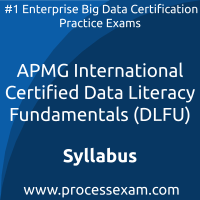 To achieve the professional designation of APMG International Data Literacy Fundamentals from the APMG International, candidates must clear the DLFU Exam with the minimum cut-off score. For those who wish to pass the APMG International Data Literacy Fundamentals certification exam with good percentage, please take a look at the following reference document detailing what should be included in APMG International Data Literacy Fundamentals Exam preparation.
To achieve the professional designation of APMG International Data Literacy Fundamentals from the APMG International, candidates must clear the DLFU Exam with the minimum cut-off score. For those who wish to pass the APMG International Data Literacy Fundamentals certification exam with good percentage, please take a look at the following reference document detailing what should be included in APMG International Data Literacy Fundamentals Exam preparation.
The APMG International DLFU Exam Summary, Body of Knowledge (BOK), Sample Question Bank and Practice Exam provide the basis for the real APMG International Certified Data Literacy Fundamentals (DLFU) exam. We have designed these resources to help you get ready to take APMG International Data Literacy Fundamentals (DLFU) exam. If you have made the decision to become a certified professional, we suggest you take authorized training and prepare with our online premium APMG International Data Literacy Fundamentals Practice Exam to achieve the best result.
APMG International DLFU Exam Summary:
| Exam Name | APMG International Data Literacy Fundamentals |
| Exam Code | DLFU |
| Exam Fee | USD $308 |
| Exam Duration | 60 Minutes |
| Number of Questions | 40 |
| Passing Score | 65% |
| Format | Multiple Choice Questions |
| Books / Trainings | Find a training provider |
| Schedule Exam | Book an exam |
| Sample Questions | APMG International Data Literacy Fundamentals Exam Sample Questions and Answers |
| Practice Exam | APMG International Certified Data Literacy Fundamentals (DLFU) Practice Test |
APMG International Data Literacy Fundamentals Syllabus Topics:
| Topic | Details |
|---|---|
|
Understand the importance of data literacy
|
- Describe the different components of data literacy:
- Describe the different levels of data literacy In organizations:
- Describe the key benefits of the data-driven organization
- Describe different personas in data literacy and their functions and objectives:
|
|
Understand fundamental data concepts
|
- Describe different data types and their objectives:
- Describe the different structure and objectives of data structures:
- Describe different types of metadata:
- Recall critical definitions that define data quality:
- Describe different storage mechanisms and their purpose in storing data:
- Recall common data security measures:
- Recall common data privacy regulations:
- Describe the different steps in the data analysis process:
- Describe common data analysis tools and technologies:
|
|
Understand how to describe data sets
|
- Recall basic definitions of data sets:
- Describe the different measures of central tendency:
- Describe the different measures of variability:
- Describe the different measures of shape:
- Describe the most common data cleaning techniques:
- Describe the objective and purpose of data wrangling
- Describe the different types of bias:
|
|
Understand and interpret data visualizations
|
- Recall the most common data visualization techniques for organizations:
- Describe the nature, use and purpose of the following data visualization techniques:
|
|
Understand how to use data to explain a story
|
- Recall the core steps of Storytelling with Data:
- Recall the core components of an effective data story:
- Describe the elements of clear and effective visualizations:
- Describe the most common data storytelling techniques:
|
|
Understand data ethics and their implications
|
- Recall the importance of data ethics:
- Describe the five principles of data ethics:
- Describe the purpose, objective, and ethical principles of data privacy
- Describe the core components of a data privacy policy:
- Describe the purpose, objective and importance of data ethics policies and procedures
- Describe enforcement mechanism of data ethics policies:
- Describe the purpose, objective, and importance of the data ethics committee
|
Both APMG International and veterans who’ve earned multiple certifications maintain that the best preparation for a APMG International DLFU professional certification exam is practical experience, hands-on training and practice exam. This is the most effective way to gain in-depth understanding of APMG International Data Literacy Fundamentals concepts. When you understand techniques, it helps you retain APMG International Data Literacy Fundamentals knowledge and recall that when needed.
